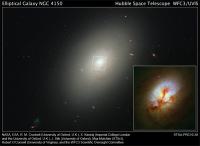Billion-year-old galaxy divulges its secret for staying young, birthing new stars
 NGC 4150, an elliptical galaxy, is 44 million light-years away. Credit: NASA, ESA
NGC 4150, an elliptical galaxy, is 44 million light-years away. Credit: NASA, ESA
New observations with NASA's Hubble Space Telescope show that elliptical galaxies grow by cannibalizing smaller galaxies.
Astronomers have discovered the secret of longevity for the aging NGC 4150 galaxy and its ability to produce new stars at the grand old age of more than a billion years.
NGC 4150 is keeping itself fat, sassy, youthful and reproductive by gobbling up a smaller neighboring galaxy, or practicing “cannibalism” as scientists put it.
Elliptical galaxies -- so called because of their oval shape "were thought to have made all of their stars billions of years ago, but we are finding evidence of star birth in many elliptical galaxies, fueled mostly by cannibalizing smaller galaxies," accroding to Mark Crockett of the University of Oxford.
Crockett, along with his team, theorize that approximately a billion years ago, NGC 4150 collided with a much smaller galaxy rich in gas that provided it with the fuel to produce more stars.
Using NASA’s Hubble Space Telescope, the team imaged NGC 4150’s core and glimpsed clumps of young, blue stars 1,300 light years across, about 85 million times the distance from the Earth to the sun, that are “significantly less than a billion years old.”
The determination that NGC 4150 collided with a much smaller galaxy is based on the meager metal content (elements heavier than hydrogen and helium) of the stars.
"This points towards a small, dwarf galaxy, around one-twentieth the mass of NGC 4150," said astronomer Sugata Kaviraj.



 del.icio.us
del.icio.us Digg
Digg












Post your comment